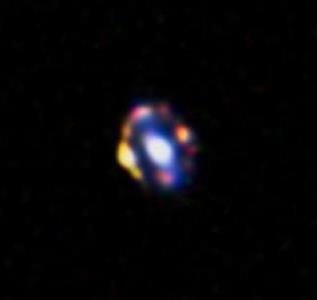|
The Well Balanced Universe |
|||
Astronomy newsRemote gravitational lens casts shadow over theory of galaxy evolution24 November 2013 The discovery of the most distant gravitational lens — a galaxy that intensifies the light of an even more distant object — poses a mystery that could challenge current ideas of how galaxies formed. As Einstein himself predicted, light is affected by gravity, and light passing a galaxy will be deflected as a result. If two galaxies are aligned properly with the earth, this can create a similar effect to a kind of lens in front of the more distant one. What the observer sees is a circle of light, called an Einstein ring, that is the projected and greatly magnified image of the distant galaxy. Since the first find in 1979, numerous such gravitational lenses have been discovered. In addition to providing tests of Einstein's theory of general relativity, gravitational lenses have proved to be valuable tools. Notably, one can determine the mass of the matter that is bending the light. The lens also magnifies the background light source, acting as a "natural telescope" that gives astronomers a more detailed look at distant galaxies than is normally possible. Now, astronomers have found the most distant gravitational lens yet. Lead author Arjen van der Wel (Max Planck Institute for Astronomy, Heidelberg, Germany) explains: "The discovery was completely by chance. I had been reviewing observations from an earlier project when I noticed a galaxy that was decidedly odd. It looked like an extremely young galaxy, but it seemed to be at a much larger distance than expected. It shouldn't even have been part of our observing programme!"
Van der Wel wanted to find out more and started to study images taken with the Hubble Space Telescope as part of the CANDELS and COSMOS surveys. In these pictures the mystery object looked like an old galaxy, a plausible target for the original observing programme, but with some irregular features which, he suspected, meant that he was looking at a gravitational lens. Combining the available images and removing the haze of the lensing galaxy's collection of stars, the result was very clear: an almost perfect Einstein ring, indicating a gravitational lens with very precise alignment of the lens and the background light source. The lensing mass is so distant that the light, after deflection, has travelled 9.4 billion years to reach us. Not only is this a new record, the object also serves an important purpose: the amount of distortion caused by the lensing galaxy allows a direct measurement of its mass. This provides an independent test for astronomers' usual methods of estimating distant galaxy masses — which rely on extrapolation from their nearby cousins. Fortunately for astronomers, their usual methods pass the test. But the discovery also poses a puzzle. Gravitational lenses are the result of a chance alignment. In this case, the alignment is very precise. To make matters worse, the magnified object is a starbursting dwarf galaxy — a type supposed to be rare. The chances that such a galaxy would be gravitationally lensed is very small, according to theory. Yet this is the second starbursting dwarf galaxy that has been found to be lensed. Either astronomers have been phenomenally lucky, or, much more probably, starbursting dwarf galaxies are far commoner than previously thought, forcing astronomers to re-think their models of galaxy evolution. Van der Wel concludes: "This has been a weird and interesting discovery. It was a completely serendipitous find, but it has the potential to start a new chapter in our description of galaxy evolution in the early Universe." |
|
||
More news ...
|
|||
